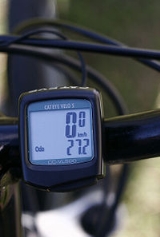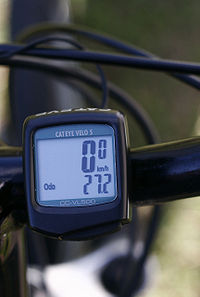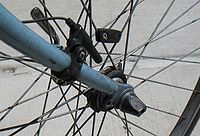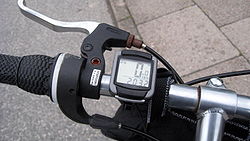
Cyclocomputer
Encyclopedia


Bicycle
A bicycle, also known as a bike, pushbike or cycle, is a human-powered, pedal-driven, single-track vehicle, having two wheels attached to a frame, one behind the other. A person who rides a bicycle is called a cyclist, or bicyclist....
that calculates and displays trip information, similar to the instruments in the dashboard
Dashboard
A dashboard is a control panel placed in front of the driver of an automobile, housing instrumentation and controls for operation of the vehicle....
of a car. The computer with display, or head unit, usually is attached to the handlebar
Bicycle handlebar
Bicycle handlebar or often bicycle handlebars refers to the steering mechanism for bicycles; the equivalent of a steering wheel. Besides steering, handlebars also often support a portion of the rider's weight, depending on their riding position, and provide a convenient mounting place for brake...
for easy viewing.
History
In 1895 Curtis Hussey Veeder invented the Cyclometer. The Cyclometer was a simple mechanical device that counted the number of rotations of a bicycle wheel. A cable transmitted the number of rotations of the wheel to an analog odometerOdometer
An odometer or odograph is an instrument that indicates distance traveled by a vehicle, such as a bicycle or automobile. The device may be electronic, mechanical, or a combination of the two. The word derives from the Greek words hodós and métron...
visible to the rider, which converted the wheel rotations into the number of miles traveled according to a predetermined formula. After founding the Veeder Manufacturing Company, Veeder promoted the Cyclometer with the slogan, It's Nice to Know How Far You Go. The Cyclometers success led to many other competing types of mechanical computing devices. Eventually, cyclometers were developed that could measure speed as well as distance traveled.
The head
A basic cyclocomputer may display the current speedSpeedometer
A speedometer is a gauge that measures and displays the instantaneous speed of a land vehicle. Now universally fitted to motor vehicles, they started to be available as options in the 1900s, and as standard equipment from about 1910 onwards. Speedometers for other vehicles have specific names...
, maximum speed, trip distance, trip time, total distance traveled
Odometer
An odometer or odograph is an instrument that indicates distance traveled by a vehicle, such as a bicycle or automobile. The device may be electronic, mechanical, or a combination of the two. The word derives from the Greek words hodós and métron...
, and the current time. More advanced models also may display altitude
Altitude
Altitude or height is defined based on the context in which it is used . As a general definition, altitude is a distance measurement, usually in the vertical or "up" direction, between a reference datum and a point or object. The reference datum also often varies according to the context...
, incline (inclinometer
Inclinometer
An inclinometer or clinometer is an instrument for measuring angles of slope , elevation or depression of an object with respect to gravity...
), heart rate
Heart rate
Heart rate is the number of heartbeats per unit of time, typically expressed as beats per minute . Heart rate can vary as the body's need to absorb oxygen and excrete carbon dioxide changes, such as during exercise or sleep....
, power output (measured in watt
Watt
The watt is a derived unit of power in the International System of Units , named after the Scottish engineer James Watt . The unit, defined as one joule per second, measures the rate of energy conversion.-Definition:...
) and temperature
Temperature
Temperature is a physical property of matter that quantitatively expresses the common notions of hot and cold. Objects of low temperature are cold, while various degrees of higher temperatures are referred to as warm or hot...
as well as offer additional functions such as average speed, pedaling cadence
Cadence (cycling)
In cycling, cadence is the number of revolutions of the crank per minute; roughly speaking, this is the rate at which a cyclist is pedalling/turning the pedals...
, a stopwatch
Stopwatch
A stopwatch is a handheld timepiece designed to measure the amount of time elapsed from a particular time when activated to when the piece is deactivated. A large digital version of a stopwatch designed for viewing at a distance, as in a sports stadium, is called a stopclock.The timing functions...
and even GPS
Global Positioning System
The Global Positioning System is a space-based global navigation satellite system that provides location and time information in all weather, anywhere on or near the Earth, where there is an unobstructed line of sight to four or more GPS satellites...
navigation. They have become useful accessories in bicycling
Cycling
Cycling, also called bicycling or biking, is the use of bicycles for transport, recreation, or for sport. Persons engaged in cycling are cyclists or bicyclists...
as a sport
Sport
A Sport is all forms of physical activity which, through casual or organised participation, aim to use, maintain or improve physical fitness and provide entertainment to participants. Sport may be competitive, where a winner or winners can be identified by objective means, and may require a degree...
and as a recreational activity.
The display is usually implemented with a liquid crystal display
Liquid crystal display
A liquid crystal display is a flat panel display, electronic visual display, or video display that uses the light modulating properties of liquid crystals . LCs do not emit light directly....
, and it may show one or more values at once. Many current models display one value, such as current speed, with large numbers, and another number that the user may select, such as time, distance, average speed, etc., with small numbers.
The head usually has one or more buttons
Button (control)
A push-button or simply button is a simple switch mechanism for controlling some aspect of a machine or a process. Buttons are typically made out of hard material, usually plastic or metal. The surface is usually flat or shaped to accommodate the human finger or hand, so as to be easily depressed...
that the user can push to switch the value(s) displayed, reset values such as time and trip distance, calibrate the unit, and on some units, turn on a back light for the display.
The wheel sensor
The older, traditional sensors have a magnet attached to a spokeSpoke
A spoke is one of some number of rods radiating from the center of a wheel , connecting the hub with the round traction surface....
of either the front or rear wheel
Bicycle wheel
A bicycle wheel is a wheel, most commonly a wire wheel, designed for bicycle. A pair is often called a wheelset, especially in the context of ready built "off the shelf" performance-oriented wheels....
. A sensor based either on the Hall effect
Hall effect
The Hall effect is the production of a voltage difference across an electrical conductor, transverse to an electric current in the conductor and a magnetic field perpendicular to the current...
, or on a magnetic reed switch
Reed switch
The reed switch is an electrical switch operated by an applied magnetic field. It was invented at Bell Telephone Laboratories in 1936 by W. B. Ellwood. It consists of a pair of contacts on ferrous metal reeds in a hermetically sealed glass envelope...
, is attached to the fork
Bicycle fork
A bicycle fork is the portion of a bicycle that holds the front wheel and allows the rider to steer and balance the bicycle. A fork consists of two fork ends which hold the front wheel axle, two blades which join at a fork crown, and a steerer or steering tube to which the handlebars attach ...
or the rear of the frame
Bicycle frame
A bicycle frame is the main component of a bicycle, on to which wheels and other components are fitted. The modern and most common frame design for an upright bicycle is based on the safety bicycle, and consists of two triangles, a main triangle and a paired rear triangle...
. The sensor detects when the magnet passes once per rotation of the wheel. Alternatively, a sensor may be attached to the wheel hub. Distance is determined by counting the number of rotations, which translates into the number of wheel circumferences passed. Speed is calculated from distance against lapsed time period. The new sensors use a magnetic field, created by a magnet attached to a spoke, to determine an angle of wheel rotation for a fixed time of several milliseconds. The sensor is mounted on a quick release and works like a compass pointing to a magnet like a north pole arrow. Magnetic field sensors provide higher accuracy of speed and acceleration measurement.
The cadence sensor
To measure cadence, a magnet is mounted to the crankarmCrankset
The crankset or chainset , is the component of a bicycle drivetrain that converts the reciprocating motion of the rider's legs into rotational motion used to drive the chain, which in turn drives the rear wheel...
, and a sensor mounted to the frame.
Transmission
Some models use a wired connection between the sensor and the head unit. Other cyclocomputers, e.g. those used by competitive cyclists, transmit the data wirelessly from the sensor/transmitter to the head unit.Calibration
Once a new computer is installed, it usually requires proper configuration. This normally includes selecting distance units (kilometers vs. miles) and the circumference of the wheel. Since the sensor measures wheel rotation, different wheel sizes will translate to different measures of speed and distance for a given number of rotations.For true accuracy, however, the bicycle (with the set cyclocomputer) must be ridden by the intended rider over an accurately measured distance. The computer's reading is then compared with the known distance and any necessary corrections made.
Additional information

Gearing
For integrated shiftersShifter (bicycle part)
A bicycle shifter or gear control or gear levers is a component used to control the gearing mechanisms and select the desired gear ratio. Typically, they operate either a derailleur mechanism or an internal hub gear mechanism. In either case, the control is operated by moving a cable that connects...
on racing bicycle
Racing bicycle
A racing bicycle, also known as a road bike, is a bicycle designed for competitive road cycling, a sport governed by according to the rules of the Union Cycliste Internationale...
s, the gear can be read by the computer: Shimano's Flight Deck and Campagnolo's ErgoBrain work with their respective systems to detect the gearing. This allows indirect measurement of cadence. These systems do not have sensors on the crankset or cassette to determine what gear the bicycle is in. They work exclusively with the shifters, which may result in misleading information. Instead of knowing what gear the bicycle is in, they rely on sensing when the cyclist changes gears using sensors in the shifters. If the gear change doesn't actually happen, or the computer's sensors are too sensitive (eg: when braking with STI-style shifters), the information displayed is not accurate.
Performance
With additional sensors, other performance measurements are available:- A heart rate monitorHeart rate monitorA heart rate monitor is a personal monitoring device which allows a subject to measure his or her heart rate in real time or record his or her heart rate for later study...
can be integrated into the computer, using a chest strap sensor. - A power meterCycling power meterA cycling power meter is a device on a bicycle that allows measuring of the power output of the rider. Most cycling power meters use strain gauges to measure torque applied, and, combined with angular velocity, calculate power...
measures powerPower (physics)In physics, power is the rate at which energy is transferred, used, or transformed. For example, the rate at which a light bulb transforms electrical energy into heat and light is measured in watts—the more wattage, the more power, or equivalently the more electrical energy is used per unit...
output in watts, using a torque sensor in the bottom bracket or rear hub.
Environment
Some models also have sensors built into the head that measure and display environmental parameters such as temperature and altitude.Cyclist power measurement
Some more sophisticated models are able to measure the rider's power in terms of watts. These units incorporate elements that measure torque at the crank, or rear wheel hub, or tension on the chain. This technology began in the late 1980s. (See Team StrawberryTeam Strawberry
Team Strawberry was a professional bicycle racing team that participated in experiments on human power/performance conducted by their primary sponsor, Balboa Instruments of Newport Beach, California. The Team was founded in 1988 by team captain Alan R. McDonald...
for the early development and testing stages of this technology.)

